International Business Strategy: Honey Australia in Austria & China
VerifiedAdded on 2023/06/07
|13
|3385
|349
Report
AI Summary
This report delves into Honey Australia's potential international market entry into Austria and China. It examines the macro environment, geopolitical forces, trade policies, and potential challenges and opportunities in both countries. Austria presents a well-established market with a skilled workforce and high living standards, while China offers rapid economic development and a large consumer base. The report identifies potential barriers to trade, such as import/export restrictions and fluctuating government regulations, but also highlights opportunities arising from favorable government policies and growing demand for organic products. Key recommendations include gathering information on currency exchange rates and import/export procedures to effectively manage potential challenges and facilitate successful market entry. This comprehensive analysis aims to provide Honey Australia with the insights needed to navigate the complexities of expanding its business into these diverse international markets. Desklib provides solved assignments and study tools for students.
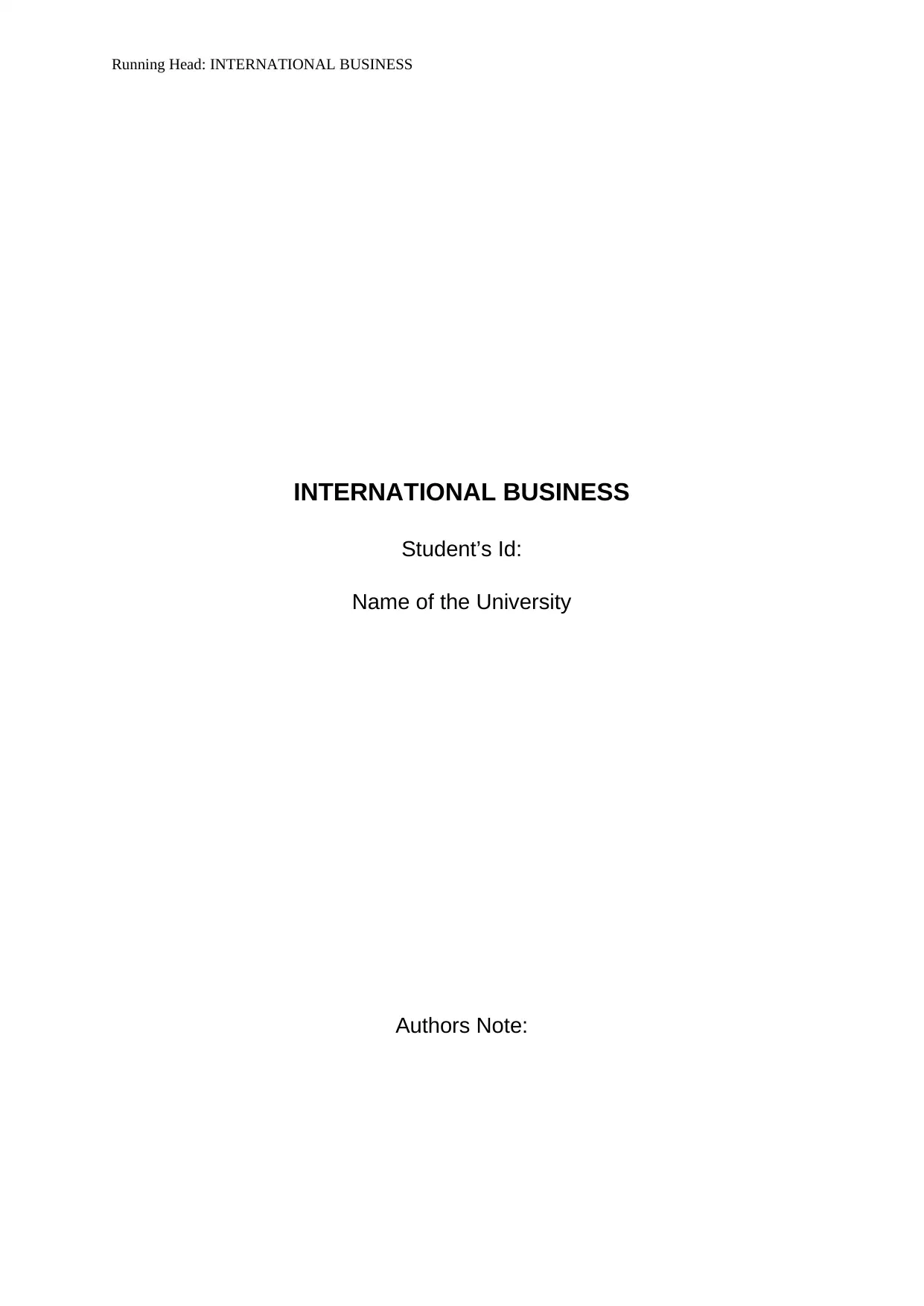
Running Head: INTERNATIONAL BUSINESS
INTERNATIONAL BUSINESS
Student’s Id:
Name of the University
Authors Note:
INTERNATIONAL BUSINESS
Student’s Id:
Name of the University
Authors Note:
Paraphrase This Document
Need a fresh take? Get an instant paraphrase of this document with our AI Paraphraser
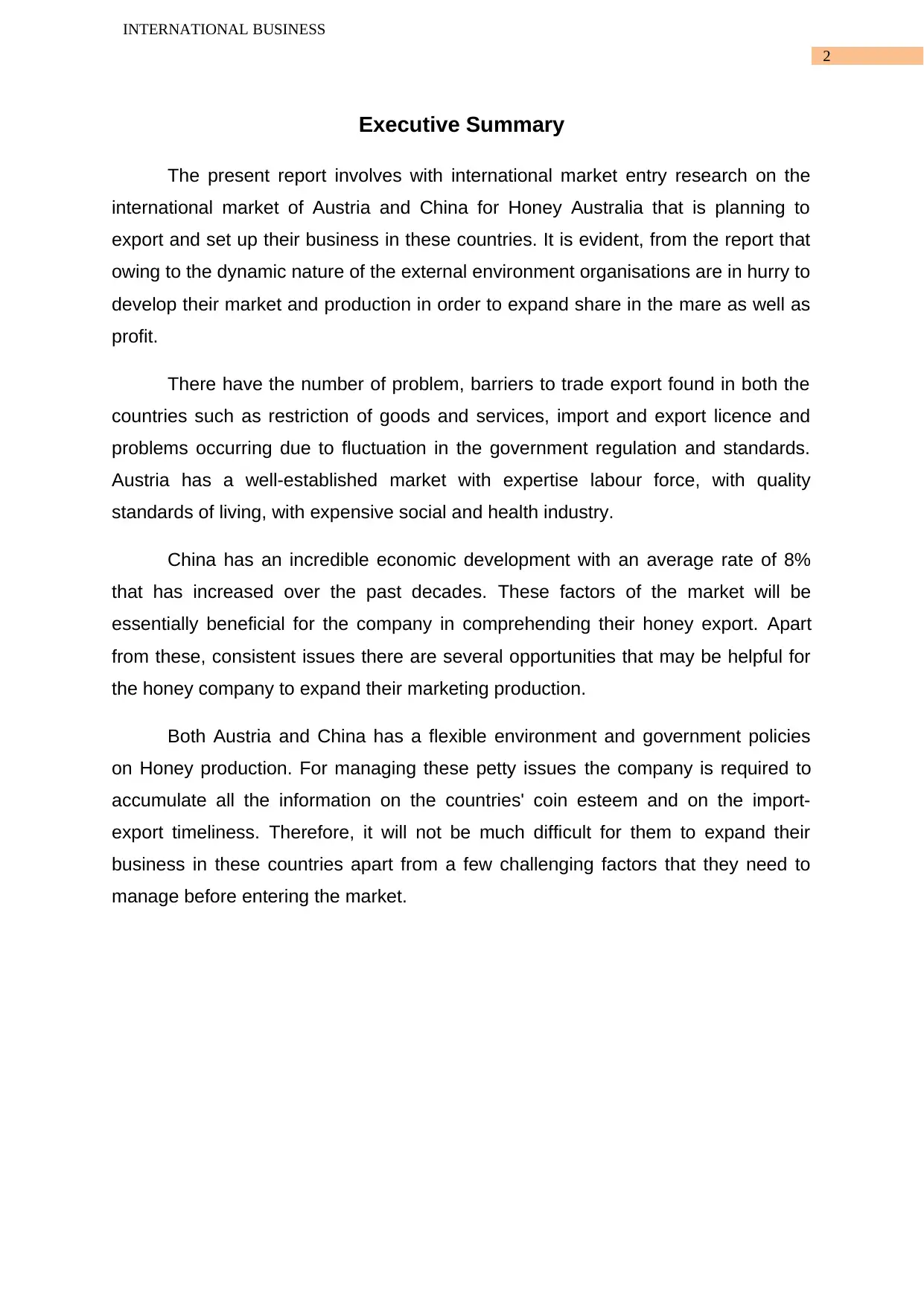
2
INTERNATIONAL BUSINESS
Executive Summary
The present report involves with international market entry research on the
international market of Austria and China for Honey Australia that is planning to
export and set up their business in these countries. It is evident, from the report that
owing to the dynamic nature of the external environment organisations are in hurry to
develop their market and production in order to expand share in the mare as well as
profit.
There have the number of problem, barriers to trade export found in both the
countries such as restriction of goods and services, import and export licence and
problems occurring due to fluctuation in the government regulation and standards.
Austria has a well-established market with expertise labour force, with quality
standards of living, with expensive social and health industry.
China has an incredible economic development with an average rate of 8%
that has increased over the past decades. These factors of the market will be
essentially beneficial for the company in comprehending their honey export. Apart
from these, consistent issues there are several opportunities that may be helpful for
the honey company to expand their marketing production.
Both Austria and China has a flexible environment and government policies
on Honey production. For managing these petty issues the company is required to
accumulate all the information on the countries' coin esteem and on the import-
export timeliness. Therefore, it will not be much difficult for them to expand their
business in these countries apart from a few challenging factors that they need to
manage before entering the market.
INTERNATIONAL BUSINESS
Executive Summary
The present report involves with international market entry research on the
international market of Austria and China for Honey Australia that is planning to
export and set up their business in these countries. It is evident, from the report that
owing to the dynamic nature of the external environment organisations are in hurry to
develop their market and production in order to expand share in the mare as well as
profit.
There have the number of problem, barriers to trade export found in both the
countries such as restriction of goods and services, import and export licence and
problems occurring due to fluctuation in the government regulation and standards.
Austria has a well-established market with expertise labour force, with quality
standards of living, with expensive social and health industry.
China has an incredible economic development with an average rate of 8%
that has increased over the past decades. These factors of the market will be
essentially beneficial for the company in comprehending their honey export. Apart
from these, consistent issues there are several opportunities that may be helpful for
the honey company to expand their marketing production.
Both Austria and China has a flexible environment and government policies
on Honey production. For managing these petty issues the company is required to
accumulate all the information on the countries' coin esteem and on the import-
export timeliness. Therefore, it will not be much difficult for them to expand their
business in these countries apart from a few challenging factors that they need to
manage before entering the market.
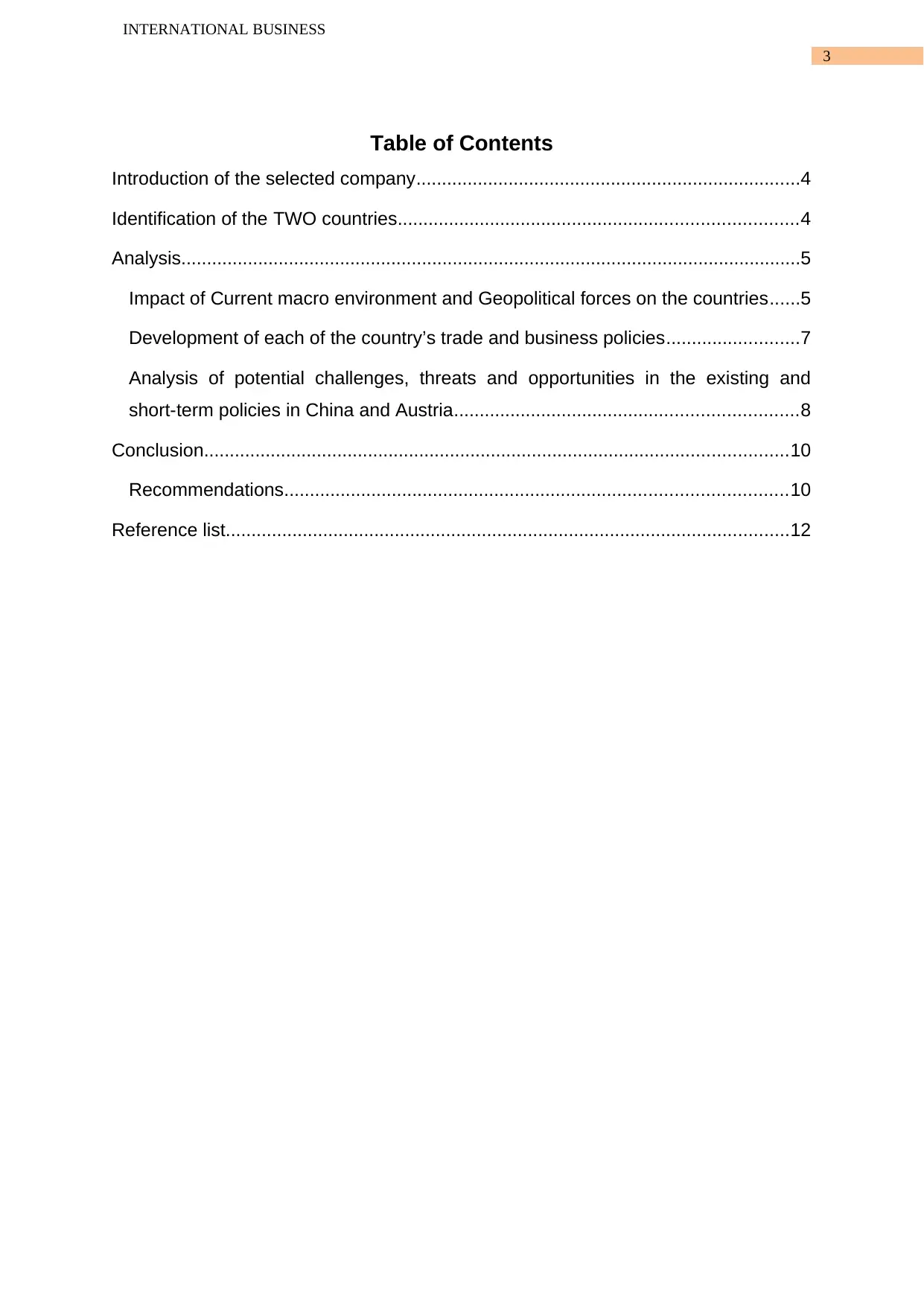
3
INTERNATIONAL BUSINESS
Table of Contents
Introduction of the selected company...........................................................................4
Identification of the TWO countries..............................................................................4
Analysis.........................................................................................................................5
Impact of Current macro environment and Geopolitical forces on the countries......5
Development of each of the country’s trade and business policies..........................7
Analysis of potential challenges, threats and opportunities in the existing and
short-term policies in China and Austria...................................................................8
Conclusion..................................................................................................................10
Recommendations..................................................................................................10
Reference list..............................................................................................................12
INTERNATIONAL BUSINESS
Table of Contents
Introduction of the selected company...........................................................................4
Identification of the TWO countries..............................................................................4
Analysis.........................................................................................................................5
Impact of Current macro environment and Geopolitical forces on the countries......5
Development of each of the country’s trade and business policies..........................7
Analysis of potential challenges, threats and opportunities in the existing and
short-term policies in China and Austria...................................................................8
Conclusion..................................................................................................................10
Recommendations..................................................................................................10
Reference list..............................................................................................................12
⊘ This is a preview!⊘
Do you want full access?
Subscribe today to unlock all pages.

Trusted by 1+ million students worldwide
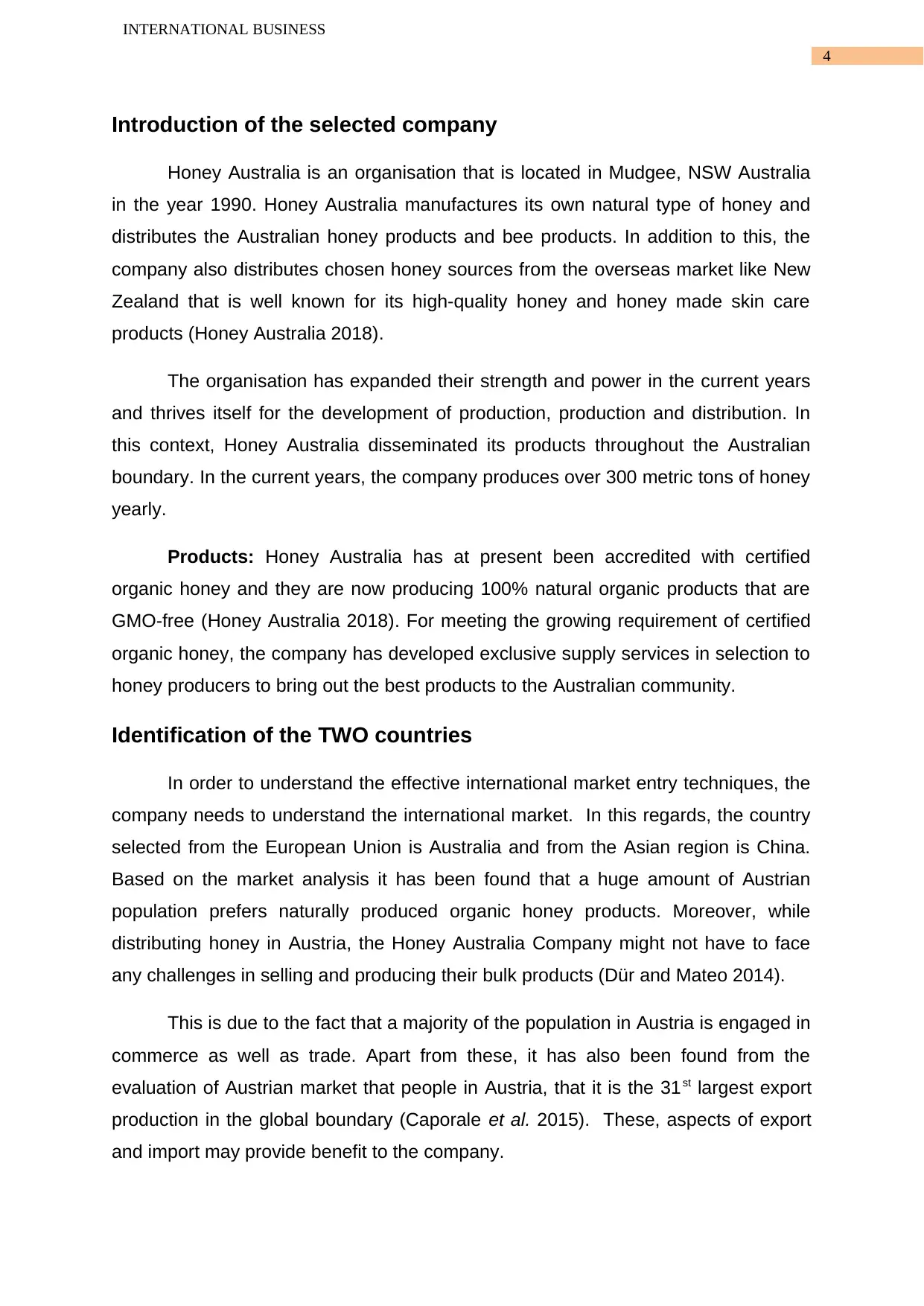
4
INTERNATIONAL BUSINESS
Introduction of the selected company
Honey Australia is an organisation that is located in Mudgee, NSW Australia
in the year 1990. Honey Australia manufactures its own natural type of honey and
distributes the Australian honey products and bee products. In addition to this, the
company also distributes chosen honey sources from the overseas market like New
Zealand that is well known for its high-quality honey and honey made skin care
products (Honey Australia 2018).
The organisation has expanded their strength and power in the current years
and thrives itself for the development of production, production and distribution. In
this context, Honey Australia disseminated its products throughout the Australian
boundary. In the current years, the company produces over 300 metric tons of honey
yearly.
Products: Honey Australia has at present been accredited with certified
organic honey and they are now producing 100% natural organic products that are
GMO-free (Honey Australia 2018). For meeting the growing requirement of certified
organic honey, the company has developed exclusive supply services in selection to
honey producers to bring out the best products to the Australian community.
Identification of the TWO countries
In order to understand the effective international market entry techniques, the
company needs to understand the international market. In this regards, the country
selected from the European Union is Australia and from the Asian region is China.
Based on the market analysis it has been found that a huge amount of Austrian
population prefers naturally produced organic honey products. Moreover, while
distributing honey in Austria, the Honey Australia Company might not have to face
any challenges in selling and producing their bulk products (Dür and Mateo 2014).
This is due to the fact that a majority of the population in Austria is engaged in
commerce as well as trade. Apart from these, it has also been found from the
evaluation of Austrian market that people in Austria, that it is the 31st largest export
production in the global boundary (Caporale et al. 2015). These, aspects of export
and import may provide benefit to the company.
INTERNATIONAL BUSINESS
Introduction of the selected company
Honey Australia is an organisation that is located in Mudgee, NSW Australia
in the year 1990. Honey Australia manufactures its own natural type of honey and
distributes the Australian honey products and bee products. In addition to this, the
company also distributes chosen honey sources from the overseas market like New
Zealand that is well known for its high-quality honey and honey made skin care
products (Honey Australia 2018).
The organisation has expanded their strength and power in the current years
and thrives itself for the development of production, production and distribution. In
this context, Honey Australia disseminated its products throughout the Australian
boundary. In the current years, the company produces over 300 metric tons of honey
yearly.
Products: Honey Australia has at present been accredited with certified
organic honey and they are now producing 100% natural organic products that are
GMO-free (Honey Australia 2018). For meeting the growing requirement of certified
organic honey, the company has developed exclusive supply services in selection to
honey producers to bring out the best products to the Australian community.
Identification of the TWO countries
In order to understand the effective international market entry techniques, the
company needs to understand the international market. In this regards, the country
selected from the European Union is Australia and from the Asian region is China.
Based on the market analysis it has been found that a huge amount of Austrian
population prefers naturally produced organic honey products. Moreover, while
distributing honey in Austria, the Honey Australia Company might not have to face
any challenges in selling and producing their bulk products (Dür and Mateo 2014).
This is due to the fact that a majority of the population in Austria is engaged in
commerce as well as trade. Apart from these, it has also been found from the
evaluation of Austrian market that people in Austria, that it is the 31st largest export
production in the global boundary (Caporale et al. 2015). These, aspects of export
and import may provide benefit to the company.
Paraphrase This Document
Need a fresh take? Get an instant paraphrase of this document with our AI Paraphraser
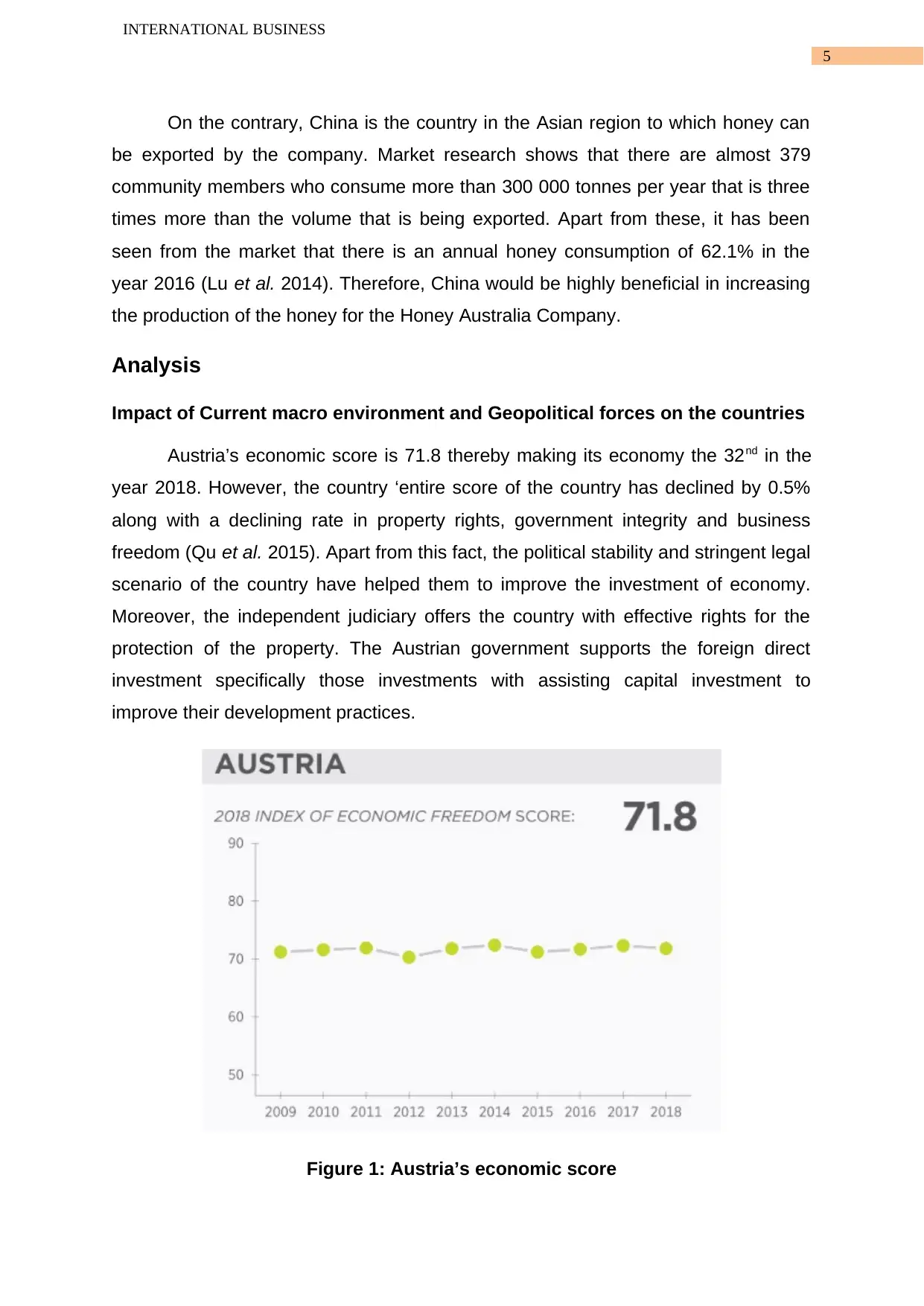
5
INTERNATIONAL BUSINESS
On the contrary, China is the country in the Asian region to which honey can
be exported by the company. Market research shows that there are almost 379
community members who consume more than 300 000 tonnes per year that is three
times more than the volume that is being exported. Apart from these, it has been
seen from the market that there is an annual honey consumption of 62.1% in the
year 2016 (Lu et al. 2014). Therefore, China would be highly beneficial in increasing
the production of the honey for the Honey Australia Company.
Analysis
Impact of Current macro environment and Geopolitical forces on the countries
Austria’s economic score is 71.8 thereby making its economy the 32nd in the
year 2018. However, the country ‘entire score of the country has declined by 0.5%
along with a declining rate in property rights, government integrity and business
freedom (Qu et al. 2015). Apart from this fact, the political stability and stringent legal
scenario of the country have helped them to improve the investment of economy.
Moreover, the independent judiciary offers the country with effective rights for the
protection of the property. The Austrian government supports the foreign direct
investment specifically those investments with assisting capital investment to
improve their development practices.
Figure 1: Austria’s economic score
INTERNATIONAL BUSINESS
On the contrary, China is the country in the Asian region to which honey can
be exported by the company. Market research shows that there are almost 379
community members who consume more than 300 000 tonnes per year that is three
times more than the volume that is being exported. Apart from these, it has been
seen from the market that there is an annual honey consumption of 62.1% in the
year 2016 (Lu et al. 2014). Therefore, China would be highly beneficial in increasing
the production of the honey for the Honey Australia Company.
Analysis
Impact of Current macro environment and Geopolitical forces on the countries
Austria’s economic score is 71.8 thereby making its economy the 32nd in the
year 2018. However, the country ‘entire score of the country has declined by 0.5%
along with a declining rate in property rights, government integrity and business
freedom (Qu et al. 2015). Apart from this fact, the political stability and stringent legal
scenario of the country have helped them to improve the investment of economy.
Moreover, the independent judiciary offers the country with effective rights for the
protection of the property. The Austrian government supports the foreign direct
investment specifically those investments with assisting capital investment to
improve their development practices.
Figure 1: Austria’s economic score
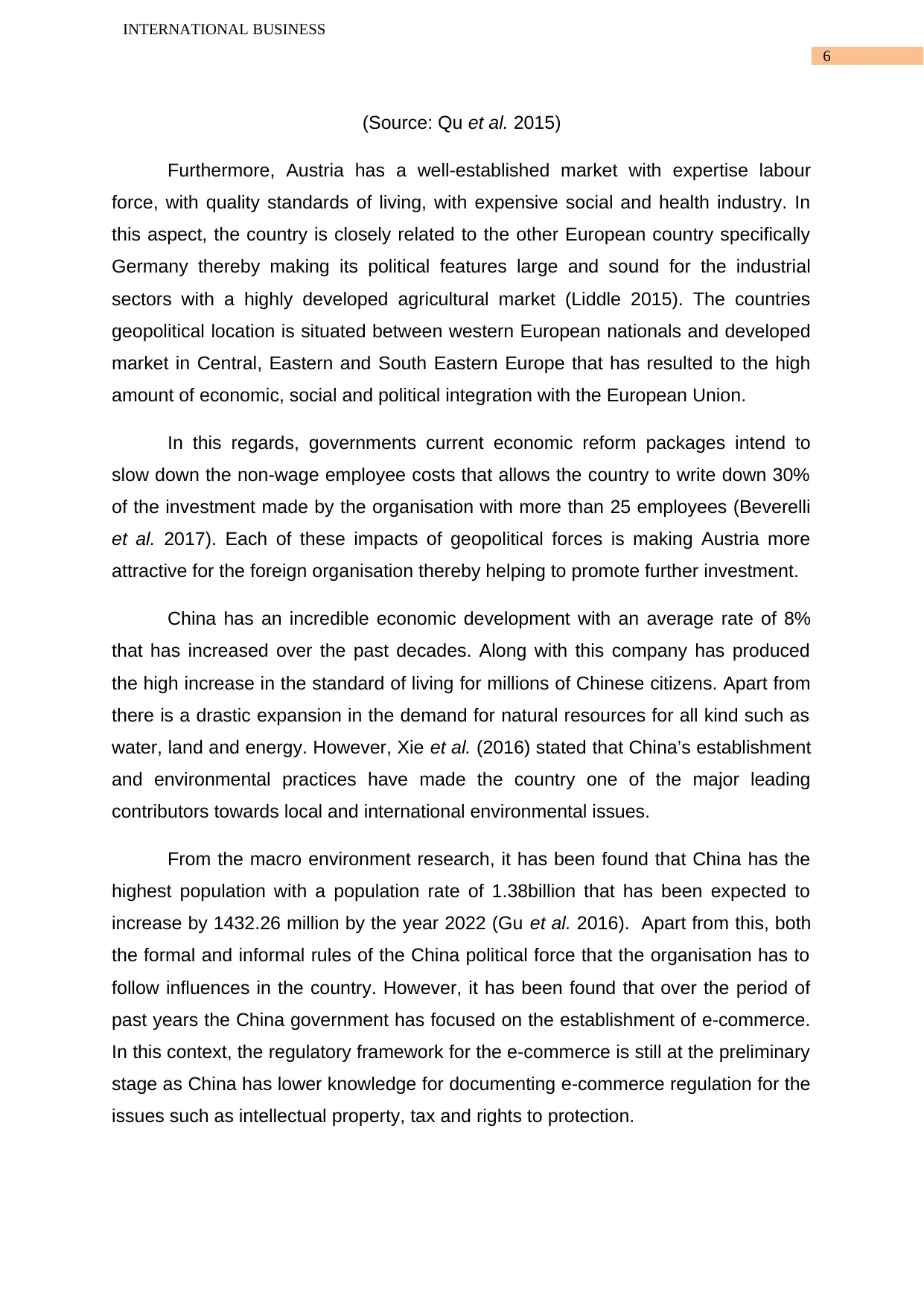
6
INTERNATIONAL BUSINESS
(Source: Qu et al. 2015)
Furthermore, Austria has a well-established market with expertise labour
force, with quality standards of living, with expensive social and health industry. In
this aspect, the country is closely related to the other European country specifically
Germany thereby making its political features large and sound for the industrial
sectors with a highly developed agricultural market (Liddle 2015). The countries
geopolitical location is situated between western European nationals and developed
market in Central, Eastern and South Eastern Europe that has resulted to the high
amount of economic, social and political integration with the European Union.
In this regards, governments current economic reform packages intend to
slow down the non-wage employee costs that allows the country to write down 30%
of the investment made by the organisation with more than 25 employees (Beverelli
et al. 2017). Each of these impacts of geopolitical forces is making Austria more
attractive for the foreign organisation thereby helping to promote further investment.
China has an incredible economic development with an average rate of 8%
that has increased over the past decades. Along with this company has produced
the high increase in the standard of living for millions of Chinese citizens. Apart from
there is a drastic expansion in the demand for natural resources for all kind such as
water, land and energy. However, Xie et al. (2016) stated that China’s establishment
and environmental practices have made the country one of the major leading
contributors towards local and international environmental issues.
From the macro environment research, it has been found that China has the
highest population with a population rate of 1.38billion that has been expected to
increase by 1432.26 million by the year 2022 (Gu et al. 2016). Apart from this, both
the formal and informal rules of the China political force that the organisation has to
follow influences in the country. However, it has been found that over the period of
past years the China government has focused on the establishment of e-commerce.
In this context, the regulatory framework for the e-commerce is still at the preliminary
stage as China has lower knowledge for documenting e-commerce regulation for the
issues such as intellectual property, tax and rights to protection.
INTERNATIONAL BUSINESS
(Source: Qu et al. 2015)
Furthermore, Austria has a well-established market with expertise labour
force, with quality standards of living, with expensive social and health industry. In
this aspect, the country is closely related to the other European country specifically
Germany thereby making its political features large and sound for the industrial
sectors with a highly developed agricultural market (Liddle 2015). The countries
geopolitical location is situated between western European nationals and developed
market in Central, Eastern and South Eastern Europe that has resulted to the high
amount of economic, social and political integration with the European Union.
In this regards, governments current economic reform packages intend to
slow down the non-wage employee costs that allows the country to write down 30%
of the investment made by the organisation with more than 25 employees (Beverelli
et al. 2017). Each of these impacts of geopolitical forces is making Austria more
attractive for the foreign organisation thereby helping to promote further investment.
China has an incredible economic development with an average rate of 8%
that has increased over the past decades. Along with this company has produced
the high increase in the standard of living for millions of Chinese citizens. Apart from
there is a drastic expansion in the demand for natural resources for all kind such as
water, land and energy. However, Xie et al. (2016) stated that China’s establishment
and environmental practices have made the country one of the major leading
contributors towards local and international environmental issues.
From the macro environment research, it has been found that China has the
highest population with a population rate of 1.38billion that has been expected to
increase by 1432.26 million by the year 2022 (Gu et al. 2016). Apart from this, both
the formal and informal rules of the China political force that the organisation has to
follow influences in the country. However, it has been found that over the period of
past years the China government has focused on the establishment of e-commerce.
In this context, the regulatory framework for the e-commerce is still at the preliminary
stage as China has lower knowledge for documenting e-commerce regulation for the
issues such as intellectual property, tax and rights to protection.
⊘ This is a preview!⊘
Do you want full access?
Subscribe today to unlock all pages.

Trusted by 1+ million students worldwide
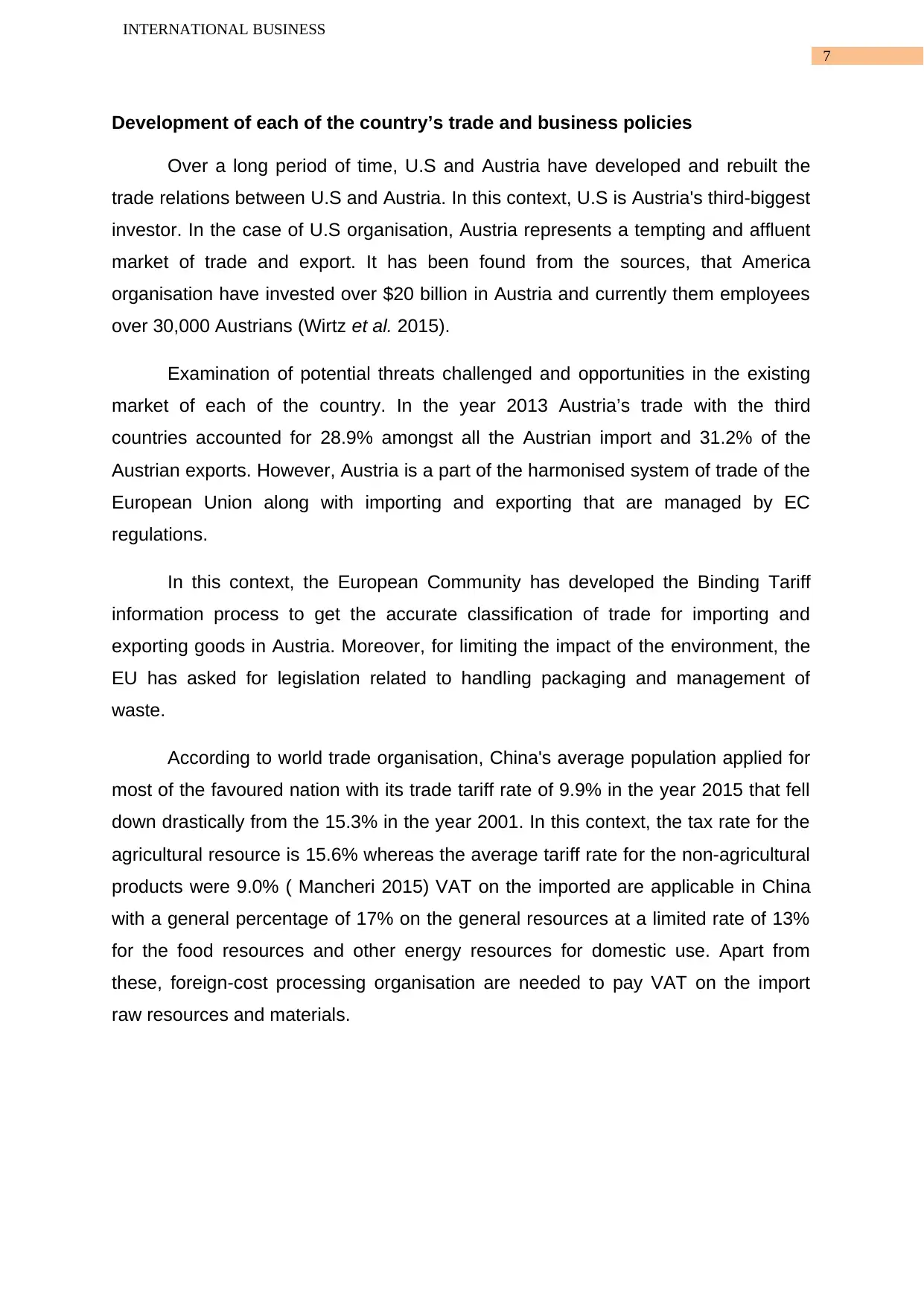
7
INTERNATIONAL BUSINESS
Development of each of the country’s trade and business policies
Over a long period of time, U.S and Austria have developed and rebuilt the
trade relations between U.S and Austria. In this context, U.S is Austria's third-biggest
investor. In the case of U.S organisation, Austria represents a tempting and affluent
market of trade and export. It has been found from the sources, that America
organisation have invested over $20 billion in Austria and currently them employees
over 30,000 Austrians (Wirtz et al. 2015).
Examination of potential threats challenged and opportunities in the existing
market of each of the country. In the year 2013 Austria’s trade with the third
countries accounted for 28.9% amongst all the Austrian import and 31.2% of the
Austrian exports. However, Austria is a part of the harmonised system of trade of the
European Union along with importing and exporting that are managed by EC
regulations.
In this context, the European Community has developed the Binding Tariff
information process to get the accurate classification of trade for importing and
exporting goods in Austria. Moreover, for limiting the impact of the environment, the
EU has asked for legislation related to handling packaging and management of
waste.
According to world trade organisation, China's average population applied for
most of the favoured nation with its trade tariff rate of 9.9% in the year 2015 that fell
down drastically from the 15.3% in the year 2001. In this context, the tax rate for the
agricultural resource is 15.6% whereas the average tariff rate for the non-agricultural
products were 9.0% ( Mancheri 2015) VAT on the imported are applicable in China
with a general percentage of 17% on the general resources at a limited rate of 13%
for the food resources and other energy resources for domestic use. Apart from
these, foreign-cost processing organisation are needed to pay VAT on the import
raw resources and materials.
INTERNATIONAL BUSINESS
Development of each of the country’s trade and business policies
Over a long period of time, U.S and Austria have developed and rebuilt the
trade relations between U.S and Austria. In this context, U.S is Austria's third-biggest
investor. In the case of U.S organisation, Austria represents a tempting and affluent
market of trade and export. It has been found from the sources, that America
organisation have invested over $20 billion in Austria and currently them employees
over 30,000 Austrians (Wirtz et al. 2015).
Examination of potential threats challenged and opportunities in the existing
market of each of the country. In the year 2013 Austria’s trade with the third
countries accounted for 28.9% amongst all the Austrian import and 31.2% of the
Austrian exports. However, Austria is a part of the harmonised system of trade of the
European Union along with importing and exporting that are managed by EC
regulations.
In this context, the European Community has developed the Binding Tariff
information process to get the accurate classification of trade for importing and
exporting goods in Austria. Moreover, for limiting the impact of the environment, the
EU has asked for legislation related to handling packaging and management of
waste.
According to world trade organisation, China's average population applied for
most of the favoured nation with its trade tariff rate of 9.9% in the year 2015 that fell
down drastically from the 15.3% in the year 2001. In this context, the tax rate for the
agricultural resource is 15.6% whereas the average tariff rate for the non-agricultural
products were 9.0% ( Mancheri 2015) VAT on the imported are applicable in China
with a general percentage of 17% on the general resources at a limited rate of 13%
for the food resources and other energy resources for domestic use. Apart from
these, foreign-cost processing organisation are needed to pay VAT on the import
raw resources and materials.
Paraphrase This Document
Need a fresh take? Get an instant paraphrase of this document with our AI Paraphraser
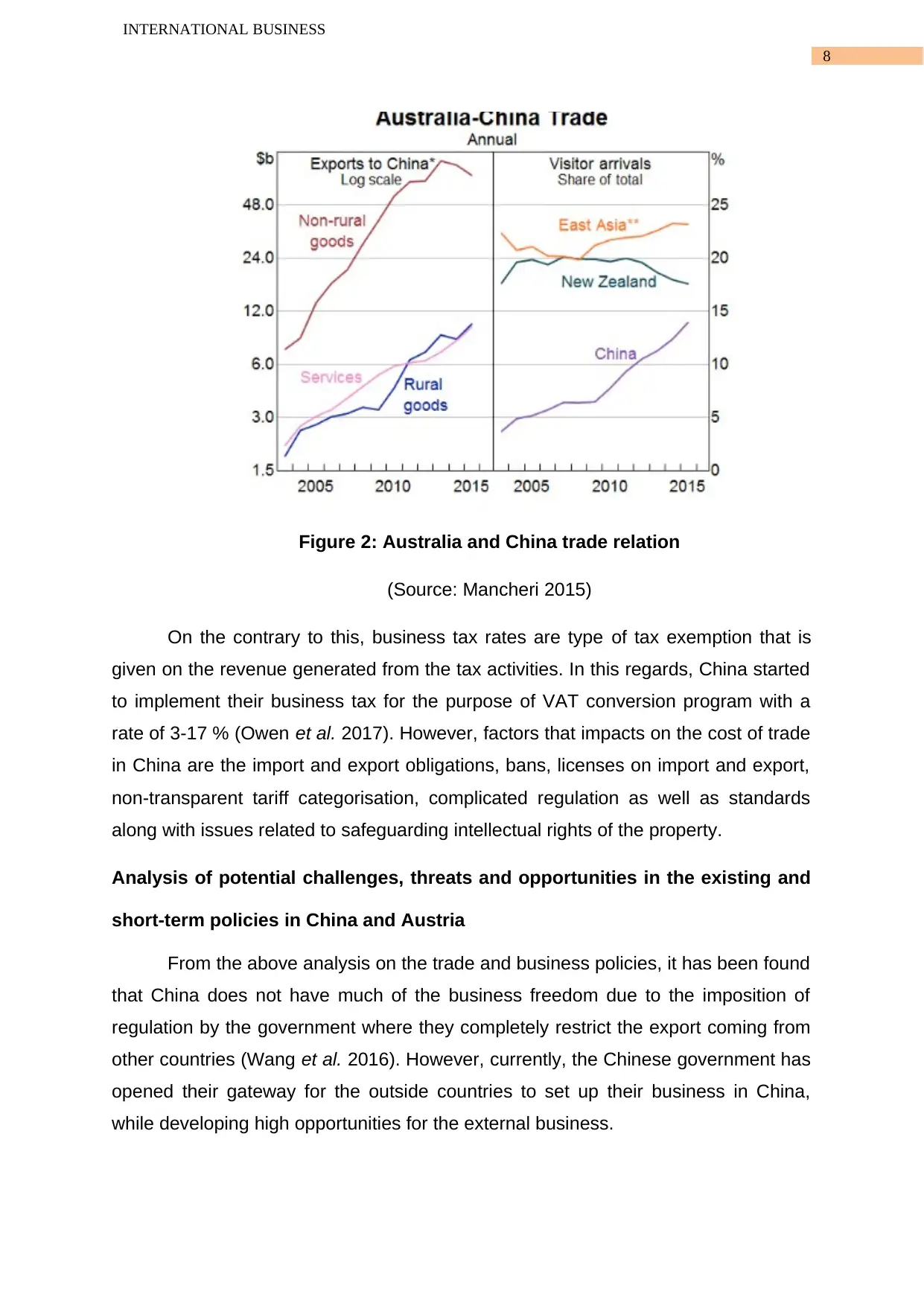
8
INTERNATIONAL BUSINESS
Figure 2: Australia and China trade relation
(Source: Mancheri 2015)
On the contrary to this, business tax rates are type of tax exemption that is
given on the revenue generated from the tax activities. In this regards, China started
to implement their business tax for the purpose of VAT conversion program with a
rate of 3-17 % (Owen et al. 2017). However, factors that impacts on the cost of trade
in China are the import and export obligations, bans, licenses on import and export,
non-transparent tariff categorisation, complicated regulation as well as standards
along with issues related to safeguarding intellectual rights of the property.
Analysis of potential challenges, threats and opportunities in the existing and
short-term policies in China and Austria
From the above analysis on the trade and business policies, it has been found
that China does not have much of the business freedom due to the imposition of
regulation by the government where they completely restrict the export coming from
other countries (Wang et al. 2016). However, currently, the Chinese government has
opened their gateway for the outside countries to set up their business in China,
while developing high opportunities for the external business.
INTERNATIONAL BUSINESS
Figure 2: Australia and China trade relation
(Source: Mancheri 2015)
On the contrary to this, business tax rates are type of tax exemption that is
given on the revenue generated from the tax activities. In this regards, China started
to implement their business tax for the purpose of VAT conversion program with a
rate of 3-17 % (Owen et al. 2017). However, factors that impacts on the cost of trade
in China are the import and export obligations, bans, licenses on import and export,
non-transparent tariff categorisation, complicated regulation as well as standards
along with issues related to safeguarding intellectual rights of the property.
Analysis of potential challenges, threats and opportunities in the existing and
short-term policies in China and Austria
From the above analysis on the trade and business policies, it has been found
that China does not have much of the business freedom due to the imposition of
regulation by the government where they completely restrict the export coming from
other countries (Wang et al. 2016). However, currently, the Chinese government has
opened their gateway for the outside countries to set up their business in China,
while developing high opportunities for the external business.
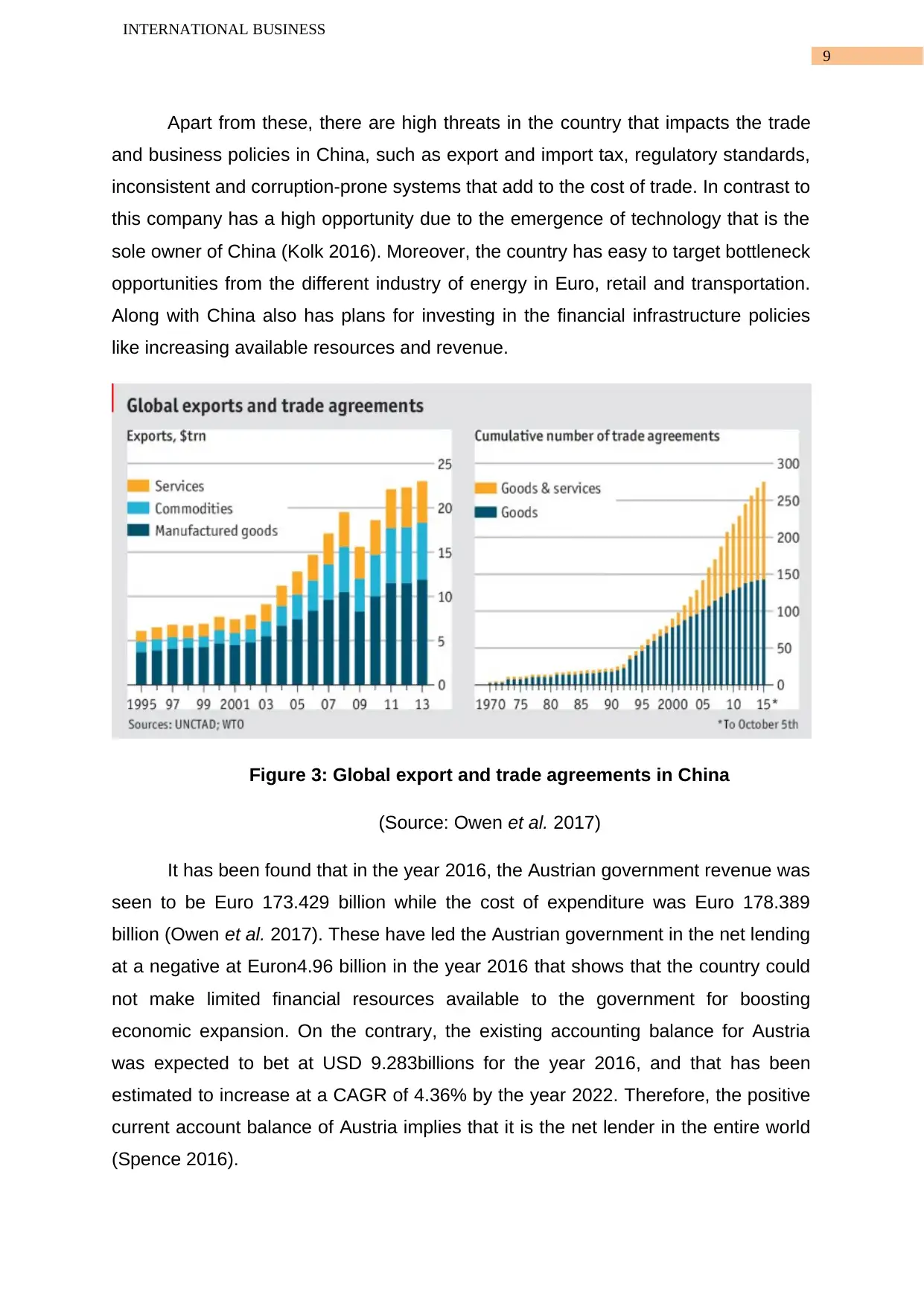
9
INTERNATIONAL BUSINESS
Apart from these, there are high threats in the country that impacts the trade
and business policies in China, such as export and import tax, regulatory standards,
inconsistent and corruption-prone systems that add to the cost of trade. In contrast to
this company has a high opportunity due to the emergence of technology that is the
sole owner of China (Kolk 2016). Moreover, the country has easy to target bottleneck
opportunities from the different industry of energy in Euro, retail and transportation.
Along with China also has plans for investing in the financial infrastructure policies
like increasing available resources and revenue.
Figure 3: Global export and trade agreements in China
(Source: Owen et al. 2017)
It has been found that in the year 2016, the Austrian government revenue was
seen to be Euro 173.429 billion while the cost of expenditure was Euro 178.389
billion (Owen et al. 2017). These have led the Austrian government in the net lending
at a negative at Euron4.96 billion in the year 2016 that shows that the country could
not make limited financial resources available to the government for boosting
economic expansion. On the contrary, the existing accounting balance for Austria
was expected to bet at USD 9.283billions for the year 2016, and that has been
estimated to increase at a CAGR of 4.36% by the year 2022. Therefore, the positive
current account balance of Austria implies that it is the net lender in the entire world
(Spence 2016).
INTERNATIONAL BUSINESS
Apart from these, there are high threats in the country that impacts the trade
and business policies in China, such as export and import tax, regulatory standards,
inconsistent and corruption-prone systems that add to the cost of trade. In contrast to
this company has a high opportunity due to the emergence of technology that is the
sole owner of China (Kolk 2016). Moreover, the country has easy to target bottleneck
opportunities from the different industry of energy in Euro, retail and transportation.
Along with China also has plans for investing in the financial infrastructure policies
like increasing available resources and revenue.
Figure 3: Global export and trade agreements in China
(Source: Owen et al. 2017)
It has been found that in the year 2016, the Austrian government revenue was
seen to be Euro 173.429 billion while the cost of expenditure was Euro 178.389
billion (Owen et al. 2017). These have led the Austrian government in the net lending
at a negative at Euron4.96 billion in the year 2016 that shows that the country could
not make limited financial resources available to the government for boosting
economic expansion. On the contrary, the existing accounting balance for Austria
was expected to bet at USD 9.283billions for the year 2016, and that has been
estimated to increase at a CAGR of 4.36% by the year 2022. Therefore, the positive
current account balance of Austria implies that it is the net lender in the entire world
(Spence 2016).
⊘ This is a preview!⊘
Do you want full access?
Subscribe today to unlock all pages.

Trusted by 1+ million students worldwide
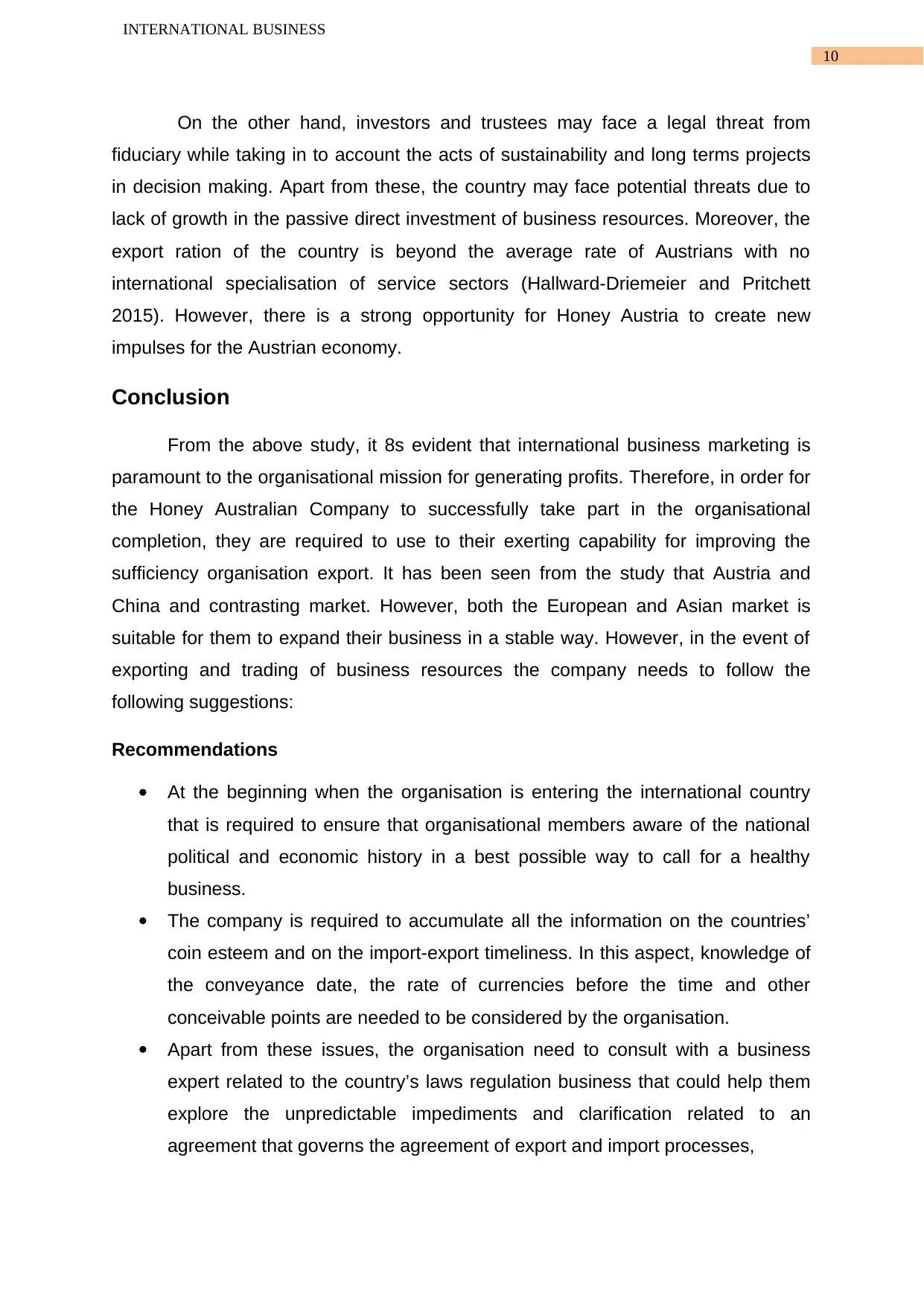
10
INTERNATIONAL BUSINESS
On the other hand, investors and trustees may face a legal threat from
fiduciary while taking in to account the acts of sustainability and long terms projects
in decision making. Apart from these, the country may face potential threats due to
lack of growth in the passive direct investment of business resources. Moreover, the
export ration of the country is beyond the average rate of Austrians with no
international specialisation of service sectors (Hallward-Driemeier and Pritchett
2015). However, there is a strong opportunity for Honey Austria to create new
impulses for the Austrian economy.
Conclusion
From the above study, it 8s evident that international business marketing is
paramount to the organisational mission for generating profits. Therefore, in order for
the Honey Australian Company to successfully take part in the organisational
completion, they are required to use to their exerting capability for improving the
sufficiency organisation export. It has been seen from the study that Austria and
China and contrasting market. However, both the European and Asian market is
suitable for them to expand their business in a stable way. However, in the event of
exporting and trading of business resources the company needs to follow the
following suggestions:
Recommendations
At the beginning when the organisation is entering the international country
that is required to ensure that organisational members aware of the national
political and economic history in a best possible way to call for a healthy
business.
The company is required to accumulate all the information on the countries’
coin esteem and on the import-export timeliness. In this aspect, knowledge of
the conveyance date, the rate of currencies before the time and other
conceivable points are needed to be considered by the organisation.
Apart from these issues, the organisation need to consult with a business
expert related to the country’s laws regulation business that could help them
explore the unpredictable impediments and clarification related to an
agreement that governs the agreement of export and import processes,
INTERNATIONAL BUSINESS
On the other hand, investors and trustees may face a legal threat from
fiduciary while taking in to account the acts of sustainability and long terms projects
in decision making. Apart from these, the country may face potential threats due to
lack of growth in the passive direct investment of business resources. Moreover, the
export ration of the country is beyond the average rate of Austrians with no
international specialisation of service sectors (Hallward-Driemeier and Pritchett
2015). However, there is a strong opportunity for Honey Austria to create new
impulses for the Austrian economy.
Conclusion
From the above study, it 8s evident that international business marketing is
paramount to the organisational mission for generating profits. Therefore, in order for
the Honey Australian Company to successfully take part in the organisational
completion, they are required to use to their exerting capability for improving the
sufficiency organisation export. It has been seen from the study that Austria and
China and contrasting market. However, both the European and Asian market is
suitable for them to expand their business in a stable way. However, in the event of
exporting and trading of business resources the company needs to follow the
following suggestions:
Recommendations
At the beginning when the organisation is entering the international country
that is required to ensure that organisational members aware of the national
political and economic history in a best possible way to call for a healthy
business.
The company is required to accumulate all the information on the countries’
coin esteem and on the import-export timeliness. In this aspect, knowledge of
the conveyance date, the rate of currencies before the time and other
conceivable points are needed to be considered by the organisation.
Apart from these issues, the organisation need to consult with a business
expert related to the country’s laws regulation business that could help them
explore the unpredictable impediments and clarification related to an
agreement that governs the agreement of export and import processes,
Paraphrase This Document
Need a fresh take? Get an instant paraphrase of this document with our AI Paraphraser
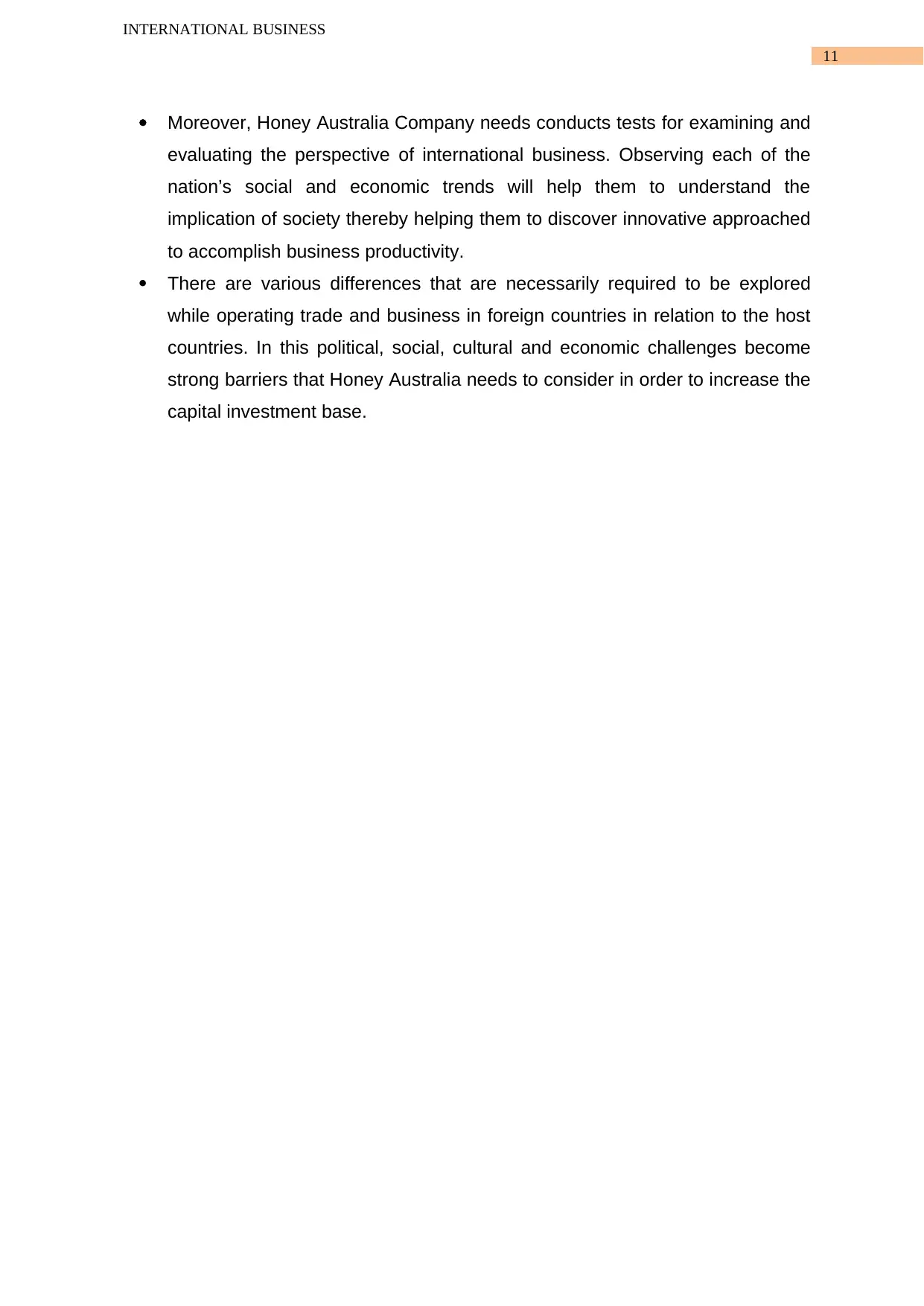
11
INTERNATIONAL BUSINESS
Moreover, Honey Australia Company needs conducts tests for examining and
evaluating the perspective of international business. Observing each of the
nation’s social and economic trends will help them to understand the
implication of society thereby helping them to discover innovative approached
to accomplish business productivity.
There are various differences that are necessarily required to be explored
while operating trade and business in foreign countries in relation to the host
countries. In this political, social, cultural and economic challenges become
strong barriers that Honey Australia needs to consider in order to increase the
capital investment base.
INTERNATIONAL BUSINESS
Moreover, Honey Australia Company needs conducts tests for examining and
evaluating the perspective of international business. Observing each of the
nation’s social and economic trends will help them to understand the
implication of society thereby helping them to discover innovative approached
to accomplish business productivity.
There are various differences that are necessarily required to be explored
while operating trade and business in foreign countries in relation to the host
countries. In this political, social, cultural and economic challenges become
strong barriers that Honey Australia needs to consider in order to increase the
capital investment base.
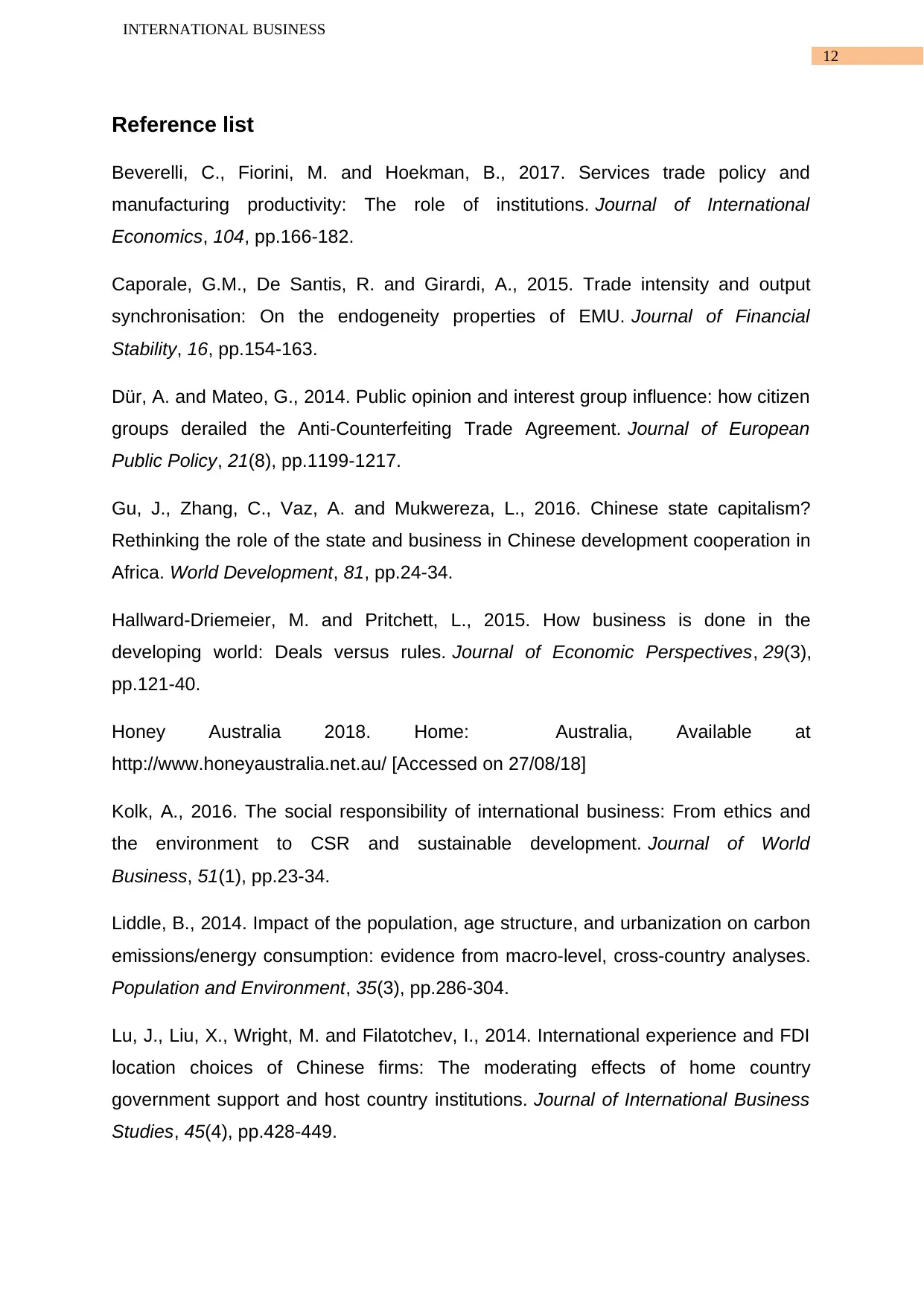
12
INTERNATIONAL BUSINESS
Reference list
Beverelli, C., Fiorini, M. and Hoekman, B., 2017. Services trade policy and
manufacturing productivity: The role of institutions. Journal of International
Economics, 104, pp.166-182.
Caporale, G.M., De Santis, R. and Girardi, A., 2015. Trade intensity and output
synchronisation: On the endogeneity properties of EMU. Journal of Financial
Stability, 16, pp.154-163.
Dür, A. and Mateo, G., 2014. Public opinion and interest group influence: how citizen
groups derailed the Anti-Counterfeiting Trade Agreement. Journal of European
Public Policy, 21(8), pp.1199-1217.
Gu, J., Zhang, C., Vaz, A. and Mukwereza, L., 2016. Chinese state capitalism?
Rethinking the role of the state and business in Chinese development cooperation in
Africa. World Development, 81, pp.24-34.
Hallward-Driemeier, M. and Pritchett, L., 2015. How business is done in the
developing world: Deals versus rules. Journal of Economic Perspectives, 29(3),
pp.121-40.
Honey Australia 2018. Home: Australia, Available at
http://www.honeyaustralia.net.au/ [Accessed on 27/08/18]
Kolk, A., 2016. The social responsibility of international business: From ethics and
the environment to CSR and sustainable development. Journal of World
Business, 51(1), pp.23-34.
Liddle, B., 2014. Impact of the population, age structure, and urbanization on carbon
emissions/energy consumption: evidence from macro-level, cross-country analyses.
Population and Environment, 35(3), pp.286-304.
Lu, J., Liu, X., Wright, M. and Filatotchev, I., 2014. International experience and FDI
location choices of Chinese firms: The moderating effects of home country
government support and host country institutions. Journal of International Business
Studies, 45(4), pp.428-449.
INTERNATIONAL BUSINESS
Reference list
Beverelli, C., Fiorini, M. and Hoekman, B., 2017. Services trade policy and
manufacturing productivity: The role of institutions. Journal of International
Economics, 104, pp.166-182.
Caporale, G.M., De Santis, R. and Girardi, A., 2015. Trade intensity and output
synchronisation: On the endogeneity properties of EMU. Journal of Financial
Stability, 16, pp.154-163.
Dür, A. and Mateo, G., 2014. Public opinion and interest group influence: how citizen
groups derailed the Anti-Counterfeiting Trade Agreement. Journal of European
Public Policy, 21(8), pp.1199-1217.
Gu, J., Zhang, C., Vaz, A. and Mukwereza, L., 2016. Chinese state capitalism?
Rethinking the role of the state and business in Chinese development cooperation in
Africa. World Development, 81, pp.24-34.
Hallward-Driemeier, M. and Pritchett, L., 2015. How business is done in the
developing world: Deals versus rules. Journal of Economic Perspectives, 29(3),
pp.121-40.
Honey Australia 2018. Home: Australia, Available at
http://www.honeyaustralia.net.au/ [Accessed on 27/08/18]
Kolk, A., 2016. The social responsibility of international business: From ethics and
the environment to CSR and sustainable development. Journal of World
Business, 51(1), pp.23-34.
Liddle, B., 2014. Impact of the population, age structure, and urbanization on carbon
emissions/energy consumption: evidence from macro-level, cross-country analyses.
Population and Environment, 35(3), pp.286-304.
Lu, J., Liu, X., Wright, M. and Filatotchev, I., 2014. International experience and FDI
location choices of Chinese firms: The moderating effects of home country
government support and host country institutions. Journal of International Business
Studies, 45(4), pp.428-449.
⊘ This is a preview!⊘
Do you want full access?
Subscribe today to unlock all pages.

Trusted by 1+ million students worldwide
1 out of 13
Related Documents
Your All-in-One AI-Powered Toolkit for Academic Success.
+13062052269
info@desklib.com
Available 24*7 on WhatsApp / Email
![[object Object]](/_next/static/media/star-bottom.7253800d.svg)
Unlock your academic potential
Copyright © 2020–2025 A2Z Services. All Rights Reserved. Developed and managed by ZUCOL.

![Report on Product Opportunity Analysis in Austria [Year]](/_next/image/?url=https%3A%2F%2Fdesklib.com%2Fmedia%2Fimages%2Fsj%2F0212bd4ad7154997be1049fbb1fb1439.jpg&w=256&q=75)



